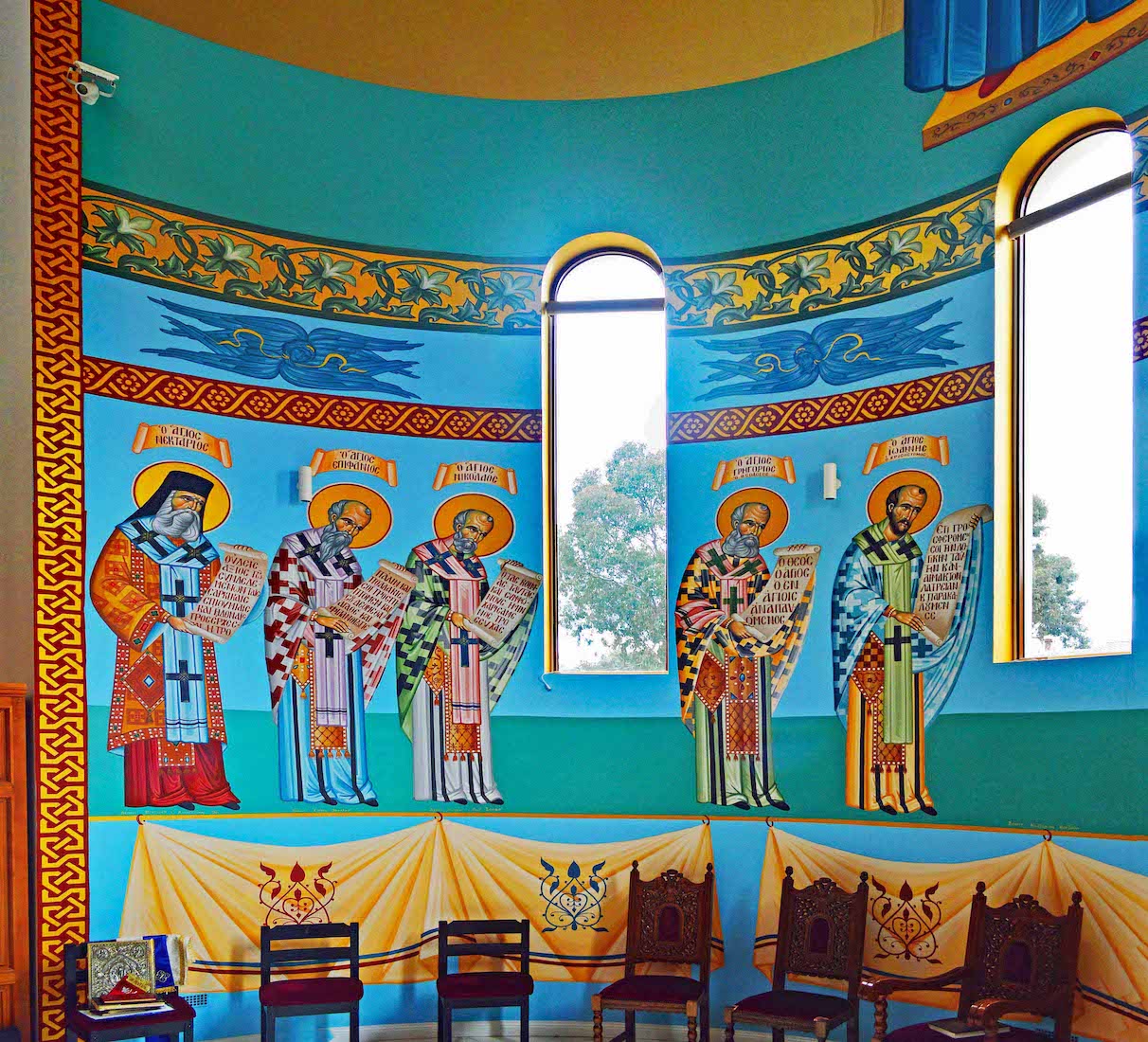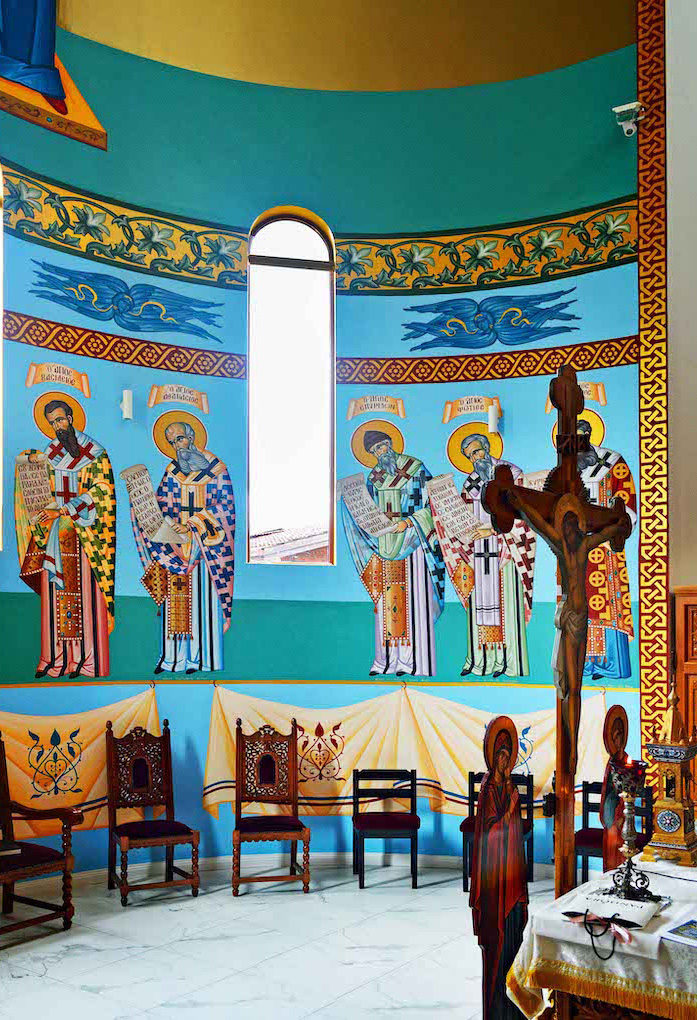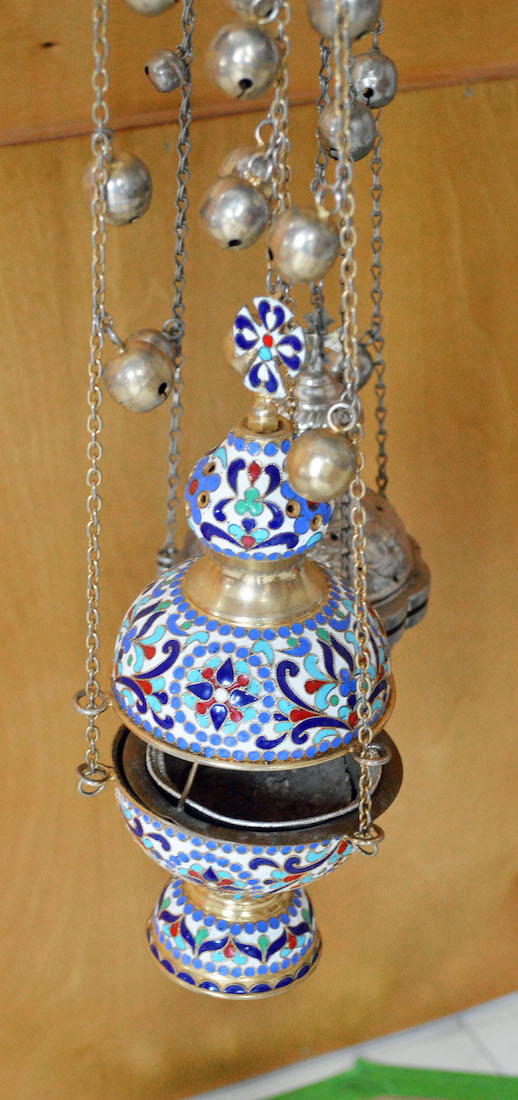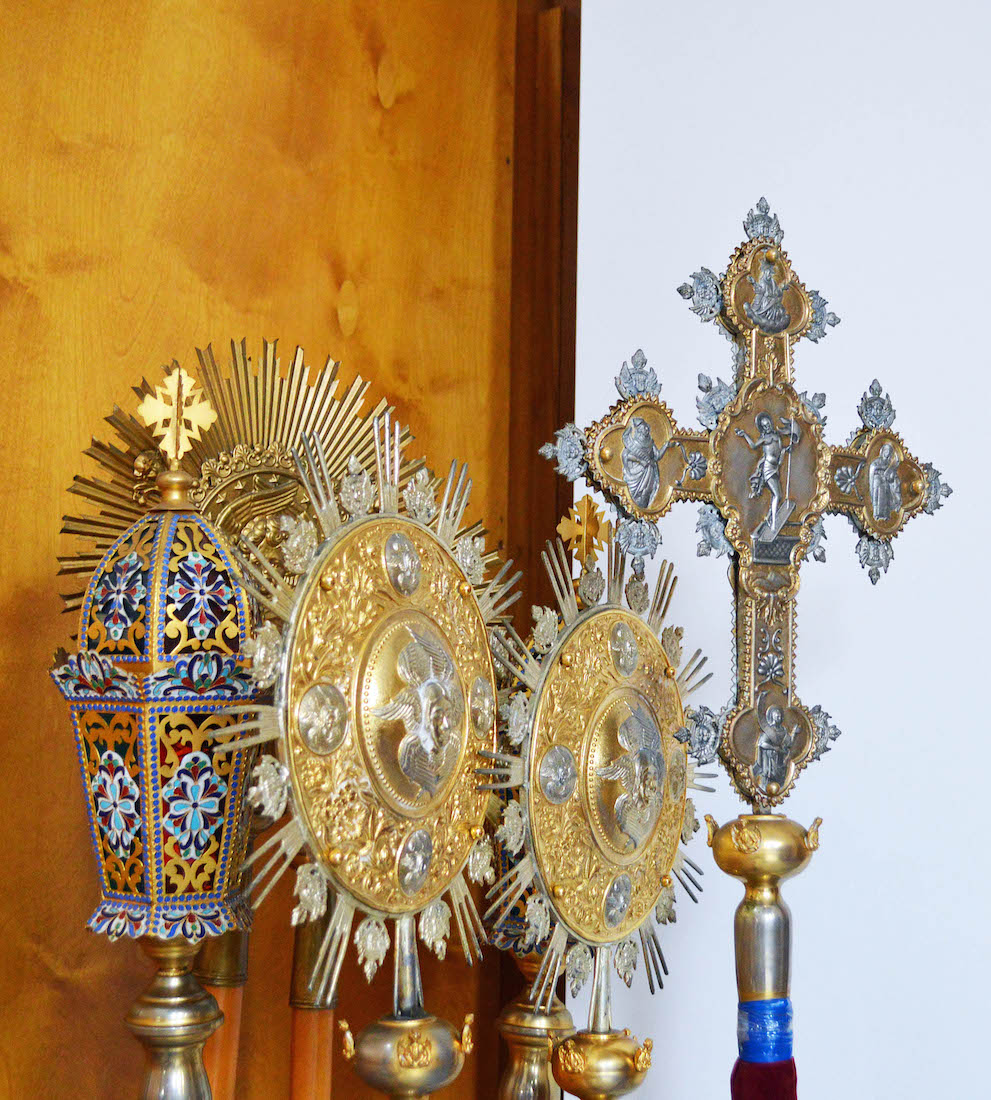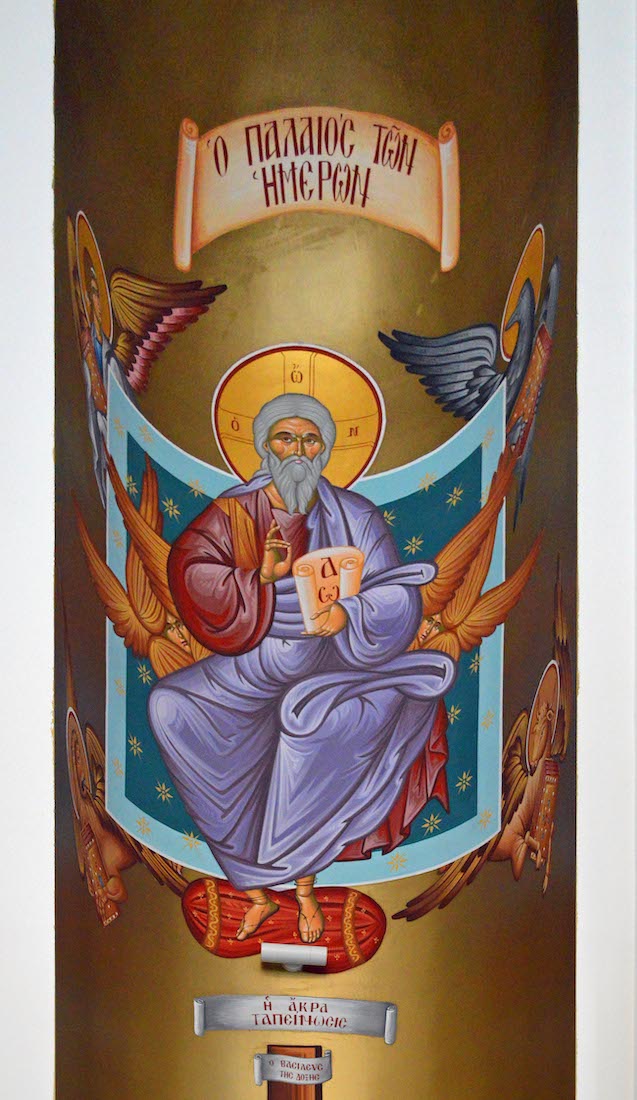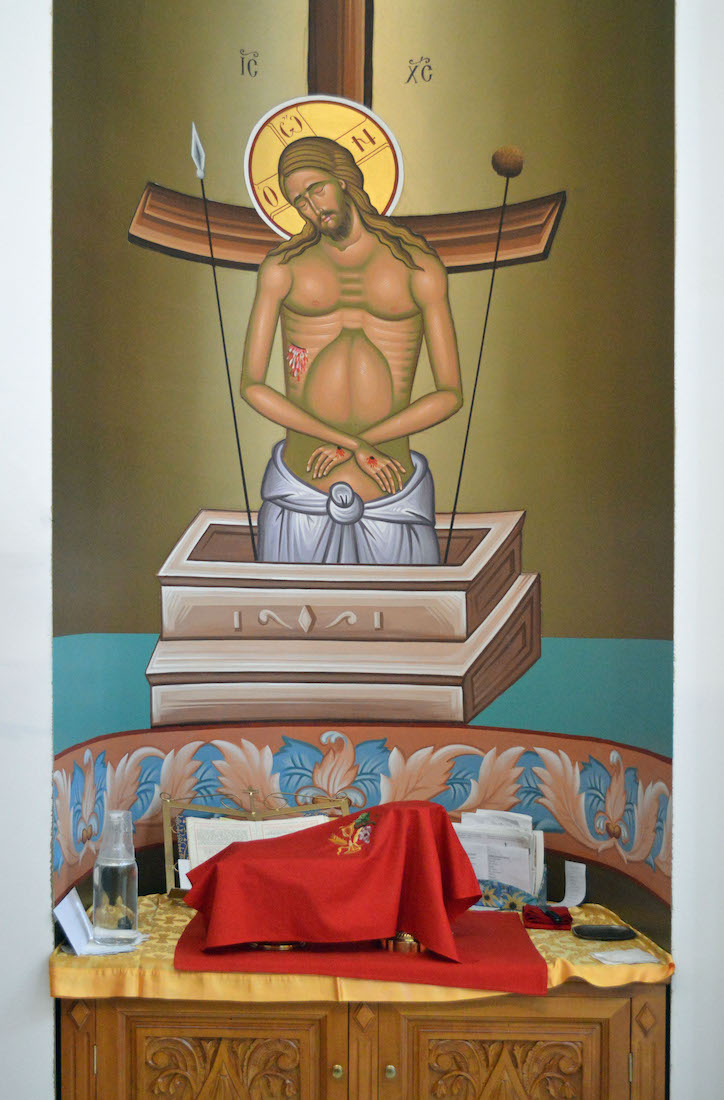
Immediately behind the altar table stands a crucifix. It has Mary the mother of Jesus and John the Evangelist standing on either side, and the INRI sign at the top (Jesus of Nazareth King of the Jews). Just at the back of the table near the foot of the cross is an interesting decorated container which may be for holding the blessed Elements of the Eucharist? INDEX
62. DECORATED CRUCIFIX
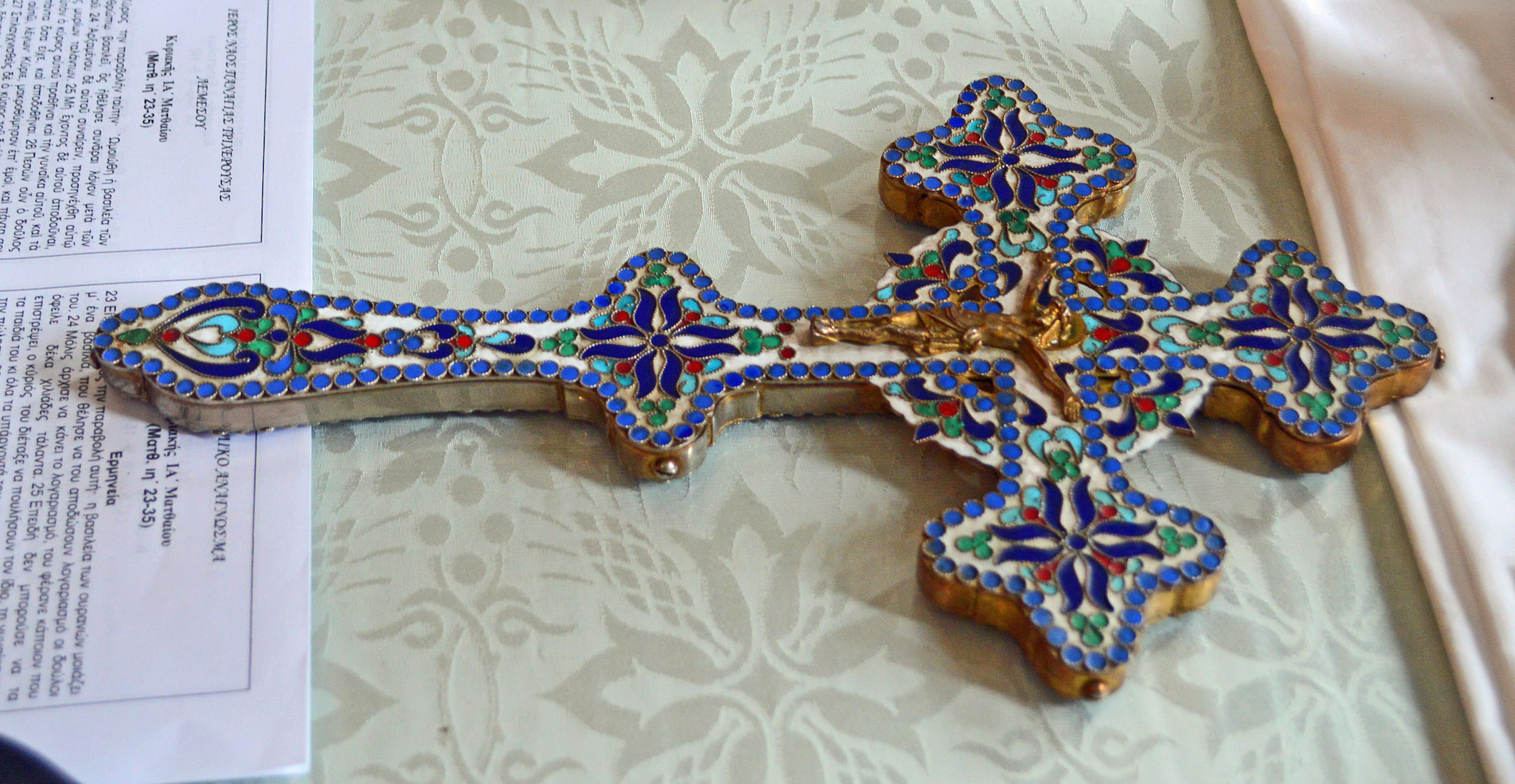
A smaller and richly decorated crucifix lies on the altar table. I suspect some of these items have an interesting historical past.
63. SANCTUARY FATHERS
Around the curved wall of the sanctuary apse there are three clear windows separating ten Church Fathers. Above the Fathers there is a foliage frieze, three blue flying angels, and a simple repetitive geometric frieze of flower heads surrounded by cursive cross-over strips. At each end there is a vertical frieze made up of two interlocking polygonal strips. But, who are the Church Fathers?
64. CHURCH FATHERS I
From left to right we have: •• Nectarios of Aegina (1846 – 1920), Metropolitan of Pentapolis and Wonderworker of Aegina. He is one of the most renowned Greek saints, venerated in the Eastern Orthodox Church and officially recognized by the Ecumenical Patriarchate of Constantinople in 1961. He is also widely venerated among Eastern Catholics. •• Epiphanius of Salamis (c. 310–320 – 403), who was the bishop of Salamis, Cyprus, at the end of the 4th century. He is considered a saint and a Church Father by both the Eastern Orthodox and Catholic Churches. He gained a reputation as a strong defender of orthodoxy. He is best known for composing the Panarion, a very large compendium of the heresies up to his own time. •• St Nicholas of Myra, Wonder-worker, was the archbishop of Myra in southern Asia Minor in the fourth century, known especially for his care for the poor. He is also the basis for the Santa Claus legends and imagery which accompany Christmas celebrations in much of the world, derived from the Dutch celebration of his feast day as the patron saint of sailors (Sinterklaas). While widely honoured and venerated, not only in the Orthodox Church, but throughout most Christian groups, little is known historically of his life. ••• Saint Gregory the Theologian is one of the Three Hierarchs along with Basil the Great and John Chrysostom. He was born in 329 AD. in Arianzus of Cappadocia. When he finished his studies at the age of 30, he was ordained an elder. Later, at the age of 43, he was ordained Bishop of Sasima and in 381 AD elected Archbishop of Constantinople by the Second Ecumenical Council and later President of the Synod, positions from which he would resign. Gregory was a great figure of the Church with a rich literary work. He is known for his famous five theological speeches against the followers of Arius and Macedonius. He died peacefully in 390 AD. at the age of 61 years. •• Saint James the Just, also called James the Brother of Our Lord (died AD 62), was the first Bishop or Patriarch of Jerusalem. According to the Protoevangelion of James, James was the son of Joseph—along with the other 'brethren of the Lord' mentioned in the scripture—from a marriage prior to his betrothal to Mary. He wrote an epistle which is part of the New Testament.
65. CHURCH FATHERS II
Again from left to right we have: •• Basil the Great (ca. 330 – 379), was bishop of Caesarea, a leading churchman in the 4th century, known especially for his philanthropic labours and theological works. The Church considers him a saint and one of the Three Holy Hierarchs, together with Saints Gregory the Theologian and John Chrysostom. •• Athanasius of Alexandria (from Greek, ‘immortal’) (198 – 373) was a bishop of Alexandria and major theological writer in the fourth century. He is also called Athanasius the Great and (by the Coptic church) Athanasius the Apostolic. ••• Spyridon of Trimythous the Wonderworker (ca. 270 – 348) was a fourth century bishop who was present at the First Ecumenical Council. He is also commonly referred to in Corfu as Keeper of the City (since he is also the patron saint of that island (this is where his relics are located and venerated). •• Photius the Great, Patriarch of Constantinople, is considered one of the greatest patriarchs of Constantinople. St. Photius was condemned as patriarch by the Robber Council of 869-870, but the Eighth Ecumenical Council (879 – 880) affirmed his restoration to his see. Although he was accused of causing the ‘Photian’ Schism, he was recognized as a major peacemaker of that time. He reconciled with Patriarch Ignatius, who named him as his successor (for a second time) upon Ignatius’ death in 877. •• Gregory Palamas (1296 – 1359), Archbishop of Thessalonica, was a monk of Mount Athos in Greece (at Vatopedi Monastery and Esphigmenou Monastery), who later became Archbishop of Thessalonica. He was a preeminent theologian and a proponent of hesychastic theology (mystical solitude).
66. INCENSE BURNER AND PROCESSIONAL ITEMS
Near the altar table hangs a colourful incense burner. Also nearby are a number of colourful items, including a processional cross.
67. NORTH SANCTUARY
The North niche in the sanctuary contains the table of preparation (‘prothesis’). Above is an image of Christ, and at top God the Father – King of Glory – He Who Is.
68. SOUTH SANCTUARY
In the South niche is an image of Jesus – Emmanuel – God with us. Below are St Stephanos and St Romanos. Stephen the Protomartyr was an early Christian convert from among the Hellenistic Jews, one of the original seven deacons ordained by the Apostles, and the first martyr of the Orthodox Church. • Saint Roman the Melodist was a Greek hymn-writer who was born at Emesa (Hems) in Syria. He is the popular patron of church singers.
69. VIRGIN MARY
We conclude our visit of this Orthodox Church with the uninterrupted ‘Mother of God’ image.

CONCLUSION
I have photographed a great many churches and cathedrals over the years, but this is my first Orthodox Church. I have found it to be a very enriching and enlightening experience, and I hope you have enjoyed visiting this Church with me.
I am grateful to the priest Father Efthymios who gave me access to the Church, and allowed me into the sanctuary area. I have also greatly appreciated the assistance of old friend and colleague John van der Hoek who helped me understand the many icons: they were all Greek to me!
I am happy to receive constructive comments or corrections concerning this website. The best websites are the ones which have no errors! I am grateful to my wife Margie who has proof-read these pages.
The Church has its own Facebook page with link
https://www.facebook.com/saintsraphaelnicholasirene/
The photographs which appear on this site can also be found in higher resolution at:
https://www.flickr.com/photos/paulscottinfo/albums/
Site created 10 / 2022
Paul Scott

